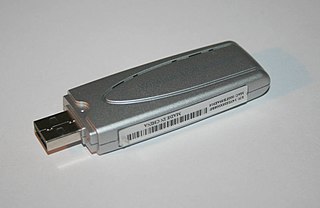
IEEE 802.11 is part of the IEEE 802 set of local area network (LAN) technical standards, and specifies the set of media access control (MAC) and physical layer (PHY) protocols for implementing wireless local area network (WLAN) computer communication. The standard and amendments provide the basis for wireless network products using the Wi-Fi brand and are the world's most widely used wireless computer networking standards. IEEE 802.11 is used in most home and office networks to allow laptops, printers, smartphones, and other devices to communicate with each other and access the Internet without connecting wires.

A wireless LAN (WLAN) is a wireless computer network that links two or more devices using wireless communication to form a local area network (LAN) within a limited area such as a home, school, computer laboratory, campus, or office building. This gives users the ability to move around within the area and remain connected to the network. Through a gateway, a WLAN can also provide a connection to the wider Internet.

AirPort is the name given to a series of products by Apple Inc. using the Wi-Fi protocols. These products comprise a number of wireless routers and wireless cards. The AirPort Extreme name was originally intended to signify the addition of the 802.11g protocol to these products.

Wi-Fi is a family of wireless network protocols, based on the IEEE 802.11 family of standards, which are commonly used for local area networking of devices and Internet access, allowing nearby digital devices to exchange data by radio waves. These are the most widely used computer networks in the world, used globally in home and small office networks to link desktop and laptop computers, tablet computers, smartphones, smart TVs, printers, and smart speakers together and to a wireless router to connect them to the Internet, and in wireless access points in public places like coffee shops, hotels, libraries and airports to provide the public Internet access for mobile devices.

The AirPort Express is a Wi-Fi base station product from Apple Inc., part of the AirPort product line. While more compact and in some ways simpler than another Apple Wi-Fi base station, the AirPort Extreme, the Express offers audio output capability the Extreme lacks. The AirPort Express was the first AirPlay device to receive streamed audio from a computer running iTunes on the local network. AirPort Express outperforms the stringent requirements of the ENERGY STAR Program Requirements for Small Network Equipment (SNE) Version 1.0.

Beacon frame is one of the management frames in IEEE 802.11 based WLANs. It contains all the information about the network. Beacon frames are transmitted periodically, they serve to announce the presence of a wireless LAN and to synchronise the members of the service set. Beacon frames are transmitted by the access point (AP) in an infrastructure basic service set (BSS). In IBSS network beacon generation is distributed among the stations. For the 2.4 GHz spectrum, when having more than 15 SSIDs on non-overlapping channels, beacon frames start to consume significant amount of air time and degrade performance even when most of the networks are idle.

A wireless network interface controller (WNIC) is a network interface controller which connects to a wireless network, such as Wi-Fi or Bluetooth, rather than a wired network, such as a Token Ring or Ethernet. A WNIC, just like other NICs, works on the layers 1 and 2 of the OSI model and uses an antenna to communicate via radio waves.
IEEE 802.11u-2011 is an amendment to the IEEE 802.11-2007 standard to add features that improve interworking with external networks.
IEEE 802.11n-2009 or 802.11n is a wireless-networking standard that uses multiple antennas to increase data rates. The Wi-Fi Alliance has also retroactively labelled the technology for the standard as Wi-Fi 4. It standardized support for multiple-input multiple-output, frame aggregation, and security improvements, among other features, and can be used in the 2.4 GHz or 5 GHz frequency bands.

High-speed multimedia radio (HSMM) is the implementation of high-speed wireless TCP/IP data networks over amateur radio frequency allocations using commercial off-the-shelf (COTS) hardware such as 802.11 Wi-Fi access points. This is possible because the 802.11 unlicensed frequency bands partially overlap with amateur radio bands and ISM bands in many countries. Only licensed amateur radio operators may legally use amplifiers and high-gain antennas within amateur radio frequencies to increase the power and coverage of an 802.11 signal.
A wireless site survey, sometimes called an RF site survey or wireless survey, is the process of planning and designing a wireless network, to provide a wireless solution that will deliver the required wireless coverage, data rates, network capacity, roaming capability and quality of service (QoS). The survey usually involves a site visit to test for RF interference, and to identify optimum installation locations for access points. This requires analysis of building floor plans, inspection of the facility, and use of site survey tools. Interviews with IT management and the end users of the wireless network are also important to determine the design parameters for the wireless network.

WaveLAN was a brand name for a family of wireless networking technology sold by NCR, AT&T, Lucent Technologies, and Agere Systems as well as being sold by other companies under OEM agreements. The WaveLAN name debuted on the market in 1990 and was in use until 2000, when Agere Systems renamed their products to ORiNOCO. WaveLAN laid the important foundation for the formation of IEEE 802.11 working group and the resultant creation of Wi-Fi.
IEEE 802.11g-2003 or 802.11g is an amendment to the IEEE 802.11 specification that operates in the 2.4 GHz microwave band. The standard has extended throughput to up to 54 Mbit/s using the same 20MHz bandwidth as 802.11b uses to achieve 11 Mbit/s. This specification under the marketing name of Wi-Fi has been implemented all over the world. The 802.11g protocol is now Clause 19 of the published IEEE 802.11-2007 standard, and Clause 19 of the published IEEE 802.11-2012 standard.
There are several uses of the 2.4 GHz band. Interference may occur between devices operating at 2.4 GHz. This article details the different users of the 2.4 GHz band, how they cause interference to other users and how they are prone to interference from other users.
WiFi-Where is a tool that facilitates detecting wireless LANs using the 802.11b, 802.11a and 802.11g WLAN standards. Versions exist for the operating systems iOS and Palm OS. Originally created in June 2004 for the Palm OS by Jonathan Hays of Hazelware Software, the IP for WiFi-Where was licensed to 3Jacks Software in 2009. An iPhone version of the application was released in January 2010, but was pulled from the App Store by Apple in March 2010. As of 2010, it is available in the Jailbroken Cydia store.
IEEE 802.11ac-2013 or 802.11ac is a wireless networking standard in the 802.11 set of protocols, providing high-throughput wireless local area networks (WLANs) on the 5 GHz band. The standard has been retroactively labelled as Wi-Fi 5 by Wi-Fi Alliance.
NetSpot is a software tool for wireless network assessment, scanning, and surveys, analyzing Wi-Fi coverage and performance. It runs on Mac OS X 10.6+ and Windows 7-8-10 and supports 802.11n, 802.11a, 802.11b, and 802.11g wireless networks. NetSpot uses the standard Wi-Fi network adapter and its Airport interface to map radio signal strength and other wireless network parameters, and build reports on that. NetSpot was released in August 2011.
IEEE 802.11ah is a wireless networking protocol published in 2017 called Wi-Fi HaLow as an amendment of the IEEE 802.11-2007 wireless networking standard. It uses 900 MHz license-exempt bands to provide extended-range Wi-Fi networks, compared to conventional Wi-Fi networks operating in the 2.4 GHz and 5 GHz bands. It also benefits from lower energy consumption, allowing the creation of large groups of stations or sensors that cooperate to share signals, supporting the concept of the Internet of things (IoT). The protocol's low power consumption competes with Bluetooth and has the added benefit of higher data rates and wider coverage range.
IEEE 802.11ax, officially marketed by the Wi-Fi Alliance as Wi-Fi 6 and Wi-Fi 6E (6 GHz), is an IEEE standard for wireless local-area networks (WLANs) and the successor of 802.11ac. It is also known as High EfficiencyWi-Fi, for the overall improvements to Wi-Fi 6 clients under dense environments. It is designed to operate in license-exempt bands between 1 and 7.125 GHz, including the 2.4 and 5 GHz bands already in common use as well as the much wider 6 GHz band.









